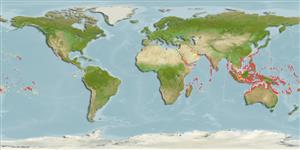Common names from other countries
>
Kurtiformes (Nurseryfishes, cardinalfishes.) >
Apogonidae (Cardinalfishes) > Apogoninae
Etymology: Fowleria: Taken from Fowler, ichthyiologist, 1945 (Ref. 45335).
More on author: Valenciennes.
Issue
Junior synonym Apogonichthys polystigma Bleeker, 1854 is considered to be valid as Fowleria polystigma in Ref. 96888.
Environment: milieu / climate zone / depth range / distribution range
Ecología
marino asociado a arrecife; rango de profundidad 0 - 27 m (Ref. 11441). Tropical; 30°N - 24°S
Indo-West Pacific: Red Sea, Oman, Persian Gulf, Kenya, Maldives; east to the Samoa Islands; north to Ryukyu Islands and south to New South Wales (Australia).
Tamaño / Peso / Age
Maturity: Lm ? range ? - ? cm
Max length : 8.0 cm TL macho / no sexado; (Ref. 9710)
Espinas dorsales (total) : 8; Radios blandos dorsales (total) : 9; Espinas anales: 2; Radios blandos anales: 8. This species is distinguished by the following characters: D VII + I,9; A II,8; pectoral fin rays 12-14; lateral-line scales 23 (23rd overlapping caudal-fin base), the first 10-13 with tubes; median predorsal scales 4; total gill-rakers 3-4 + 11-13; developed rakers 1+ 5-6; rear edge of preopercle ridge smooth, the lower edge membranous and crenulate; body depth 2.5-2.95, head length 2.3-2.4 in SL; snout length 4.2-4.5, eye diameter 3.1-3.8, interorbital width 5.8-7.05, and upper-jaw length 1.9-2.0, all in head length; jaws and vomer with villiform teeth in bands, none on palatines; caudal-peduncle depth 1.15-1.45 in peduncle length, and peduncle length 4.2-4.7 in SL; round shaped caudal fin (Ref. 50837).
Found in coral reefs and seagrass beds of inner bays and shallow lagoons (Ref. 1602); also in dead reef and rubble (Ref. 48635). Nocturnal species (Ref. 7300). Solitary or in small groups (Ref 90102).
Life cycle and mating behavior
Maturities | Reproducción | Spawnings | Egg(s) | Fecundities | Larva
CDistinct pairing during courtship and spawning (Ref. 205).
Gon, O. and J.E. Randall, 2003. A review of the cardinalfishes (Perciformes: Apogonidae) of the Rea Sea. Smithiana Bull. 1:1-47. (Ref. 50837)
IUCN Red List Status (Ref. 130435)
CITES (Ref. 128078)
Not Evaluated
Threat to humans
Harmless
Human uses
Herramientas
Special reports
Download XML
Fuentes de Internet
Estimates based on models
Preferred temperature (Ref.
115969): 25.3 - 29.3, mean 28.4 (based on 3220 cells).
Phylogenetic diversity index (Ref.
82804): PD
50 = 0.5078 [Uniqueness, from 0.5 = low to 2.0 = high].
Bayesian length-weight: a=0.01413 (0.00837 - 0.02384), b=3.13 (2.99 - 3.27), in cm Total Length, based on LWR estimates for this species & (Sub)family-body (Ref.
93245).
Nivel trófico (Ref.
69278): 3.5 ±0.50 se; based on food items.
Resiliencia (Ref.
120179): Alto, población duplicada en un tiempo mínimo inferior a 15 meses (Preliminary K or Fecundity.).
Fishing Vulnerability (Ref.
59153): Low vulnerability (10 of 100).
